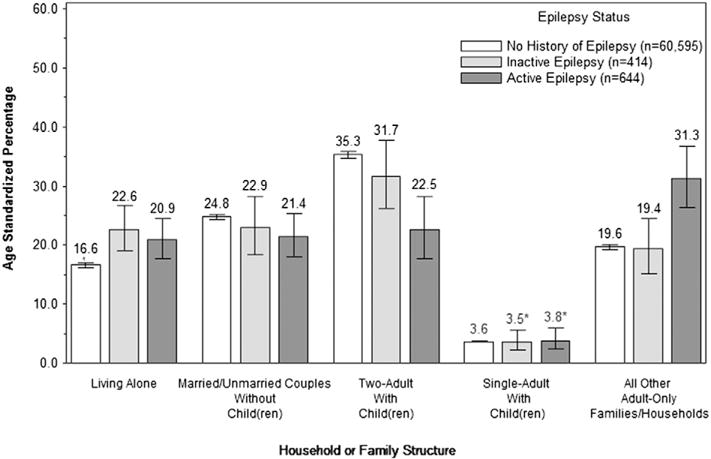Fig. 1.

Age-standardized1 percentage distribution of household or family structure2 for adults (18 years and above) by epilepsy status3—National Health Interview Survey4, United States, 2010 and 2013. Notes: ¶95% confidence interval for age-standardized percentage of each point estimate shown in the graph. *These estimates are unreliable because they have relative standard errors (RSE) ≥20% and b30%. 1Estimates are age-standardized (18–24, 25–34, 35–44, 45–54, 55–64, 65+) using the projected 2000 US population as the standard population. 2Family structure is measured by an NHIS-recoded variable with 13 mutually exclusive response values that take into account parental marital status and the type of relationship (e.g., biological, adoptive, step-) between children aged 0–17 years and any parents present in the family. Because of the small sample sizes of some of these responses, we combined and further recoded them into five levels. For example, married/unmarried couples include both married and unmarried couples without any children. Two-adult households/families with child(ren) consist of five categories: parents with child(ren), one parent and one step-parent with child(ren), one parent and one cohabiting partner with child(ren), at least one parent and other related adults with child(ren), and other related and/or unrelated adults with child(ren). Single-adult households/families include responses of mother with child(ren) only, father with child(ren) only, and all other single-adult with child(ren) categories. All other adult-only households/families include categories of all other adult-only families and living with roommate(s). 3Epilepsy status is measured based on responses to three questions, 1). “Have you ever been told by a doctor or other health professional that you have a seizure disorder or epilepsy?”; 2). “Are you currently taking any medicine to control your seizure disorder or epilepsy?”; and 3). “Today is [fill: Current Date]. Think back to last year about the same time. About how many seizures of any type have you had in the past year.” Adults who responded “No” to the first question were considered as having no history of epilepsy. Respondents who answered “Yes” to the first question, “no” or “do not know” to the second question, and reported having zero seizures during the past year for the third question were considered as having inactive epilepsy. Adults who answered “yes” to the first two questions or if they reported one or more seizures during the past year in response to the third question were considered as having active epilepsy. The case-ascertainment questions and case-classification definitions follow standards for epidemiologic studies of epilepsy and have acceptable positive predictive value for identifying clinical cases of epilepsy [5]. 4Estimates are based on household interviews of a nationally representative sample of the noninstitutionalized U.S. civilian population and are derived from the National Health Interview Survey. This analysis used the sample adult, person, and family files and was weighted using sample adult weight. Complex survey design was also accounted for.
